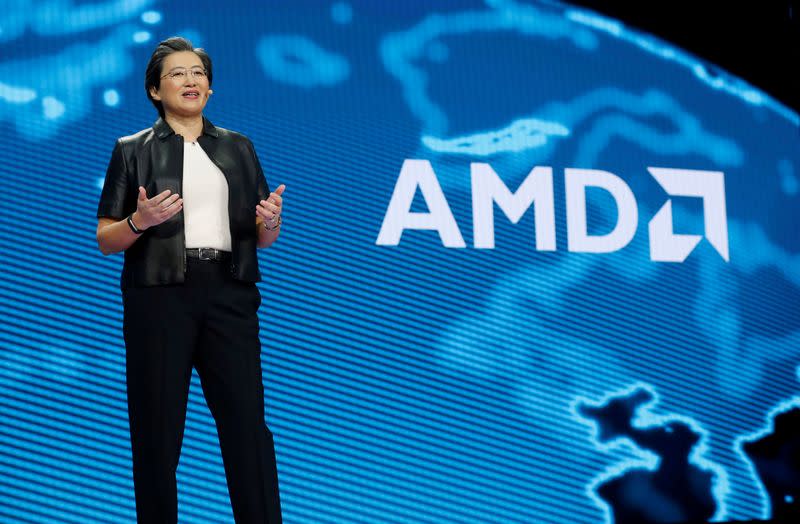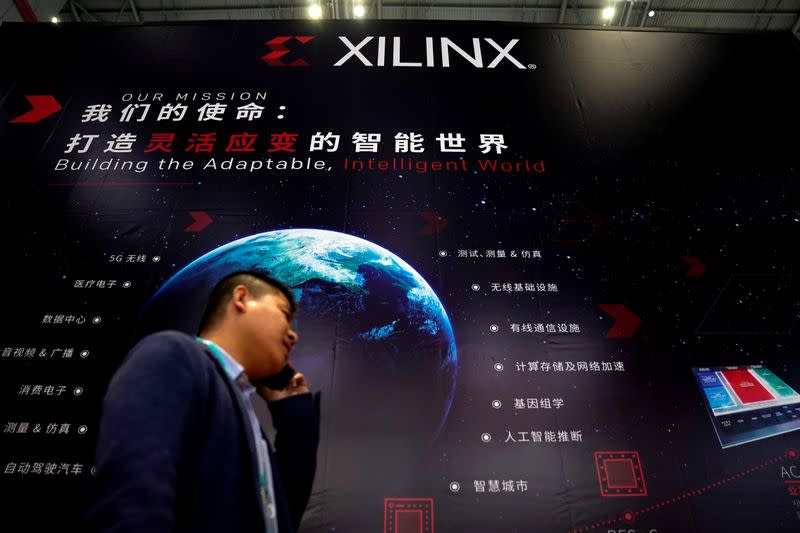AMD to buy chip peer Xilinx for $35 billion in data center push
By Stephen Nellis
(Reuters) - Semiconductor designer Advanced Micro Devices Inc (AMD) said on Tuesday it would buy Xilinx Inc in a $35 billion all-stock deal, intensifying its battle with Intel Corp in the data center chip market.
The deal, which AMD expects to close at the end of 2021, will create a combined company with 13,000 engineers and a completely outsourced manufacturing strategy that relies heavily on Taiwan Semiconductor Manufacturing Co Ltd (TSMC).
The two U.S. companies have benefited from a more nimble approach to grab market share from Intel, which has struggled with internal manufacturing.
AMD has long been Intel's chief rival for central processor units (CPUs) in the personal computer business.
Since Chief Executive Lisa Su took over AMD in 2014, she has focused on challenging Intel in the fast-growing business of data centers that power internet-based applications and services and are fueling the rise of artificial intelligence and fifth-generation telecommunications networks.
Xilinx has also been working to penetrate data centers with programmable processors that help speed up specialized tasks such as compressing videos or providing digital encryption. Its primary rival in the area, Altera Corp, was scooped up by Intel for $16.7 billion in 2015 in what was then Intel's largest-ever deal.
"There are some areas where we're very strong, and we will be able to accelerate some of the adoption of the Xilinx product family," Su told Reuters in an interview. "And there are some areas where (Xilinx CEO) Victor (Peng) is very strong, and we believe that we'll be able to accelerate some of the AMD products into those markets."
The tie-up comes at a time when Intel's manufacturing technology has fallen years behind TSMC's. AMD, which spun off its factories nearly a decade ago, has rocketed ahead of Intel with chips that perform better. The performance edge helped AMD gain its best market share since 2013 at slightly less than 20% of the CPU market, which has in turn pushed its shares up 79% this year.
Shares of AMD were down 1.8% shortly after markets opened at 9:30 a.m. ET (1330 GMT), while those of Xilinx surged nearly 12% after the two companies held a joint conference call about the deal.
Xilinx also uses TSMC's factories, called "fabs" in the industry, to make its chips, with both U.S. companies using modular designs that let them swap out different pieces of a chip to avoid bottlenecks or delays.
"We ended up with TSMC, and have stayed with them, not due to any contractual reason - we could go to any fab at any time - but because they are best-in-class," Peng told Reuters in an interview. "It's about the choices you make."
Under the deal, Xilinx shareholders will receive about 1.7 shares of AMD common stock for each share of Xilinx common stock, valuing Xilinx at $143 per share based on a 10-day average for AMD share prices up to Oct. 8, or about 24.8% higher than its $114.55 closing price on Oct. 26. AMD shareholders will own about 74% of the combined firm, with Xilinx shareholders owning the remaining 26%.
AMD's Su will lead the combined company as chief executive, with Xilinx's Peng serving as president responsible for the Xilinx business and strategic growth initiatives. The companies expect the deal to generate $300 million in cost savings.
AMD also reported earnings on Tuesday earlier than scheduled. It reported revenue and adjusted earnings of $2.80 billion and 41 cents per share, beating Wall Street expectations of $2.57 billion and 36 cents per share, according to IBES data from Refinitiv.
Bernstein analyst Stacy Rasgon said there is a danger that a major acquisition in an adjacent chip market could distract AMD's leadership while Intel fights to regain market share.
"The worry would be, AMD has this great self-grown story of their own, which is just starting to play out. Why are you doing this now? Is it just opportunistic? Does it distract from the current story?" he said.
Xilinx's Peng, however, said meetings between the two companies have already revealed they have very similar methods for designing chips.
"I'll be honest, I don't think it's really as challenging as some other combinations," he said. "I had one of my leadership teams who was not familiar with AMD say to me after a meeting, 'Boy, they're just like us.'"
(Reporting by Stephen Nellis in San Francisco and Munsif Vengattil in Bengaluru; Editing by David Gregorio, Anil D'Silva and Jonathan Oatis)

 Yahoo Finance
Yahoo Finance 

